
RESEARC H Open Access
Prognostic impact of clinical course-specific
mRNA expression profiles in the serum of
perioperative patients with esophageal cancer in
the ICU: a case control study
Shunsaku Takahashi
1,2
, Norimasa Miura
2*
, Tomomi Harada
1,2
, ZhongZhi Wang
2
, Xinhui Wang
2
,
Hideyuki Tsubokura
3
, Yoshiaki Oshima
1,4
, Junichi Hasegawa
2
, Yoshimi Inagaki
1
, Goshi Shiota
5
Abstract
Background: We previously reported that measuring circulating serum mRNAs using quantitative one-step real-
time RT-PCR was clinically useful for detecting malignancies and determining prognosis. The aim of our study was
to find crucial serum mRNA biomarkers in esophageal cancer that would provide prognostic information for post-
esophagectomy patients in the critical care setting.
Methods: We measured serum mRNA levels of 11 inflammatory-related genes in 27 post-esophagectomy patients
admitted to the intensive care unit (ICU). We tracked these levels chronologically, perioperatively and
postoperatively, until the two-week mark, investigating their clinical and prognostic significance as compared with
clinical parameters. Furthermore, we investigated whether gene expression can accurately predict clinical outcome
and prognosis.
Results: Circulating mRNAs in postoperative esophagectomy patients had gene-specific expression profiles that
varied with the clinical phase of their treatment. Multivariate regression analysis showed that upregulation of IL-6,
VWF and TGF-b1 mRNA in the intraoperative phase (p = 0.016, 0.0021 and 0.009) and NAMPT and MUC1 mRNA on
postoperative day 3 (p < 0.01) were independent factors of mortality in the first year of follow-up. Duration of
ventilator dependence (DVD) and ICU stay were independent factors of poor prognosis (p < 0.05). Therapeutic use
of Sivelestat (Elaspol®, Ono Pharmaceutical Co., Ltd.) significantly correlated with MUC1 and NAMPT mRNA
expression (p = 0.048 and 0.045). IL-6 mRNA correlated with hypercytokinemia and recovery from hypercytokinemia
(sensitivity 80.9%) and was a significant biomarker in predicting the onset of severe inflammatory diseases.
Conclusion: Chronological tracking of postoperative mRNA levels of inflammatory-related genes in esophageal
cancer patients may facilitate early institution of pharamacologic therapy, prediction of treatment response, and
prognostication during ICU management in the perioperative period.
Background
Esophageal cancer is one of the most aggressive malig-
nant tumors of the digestive tract. Post-esophagectomy
anastomotic leak and pneumonia are common and can
lead to acute respiratory distress syndrome (ARDS).
Acute respiratory distress syndrome (ARDS) is a diffuse
heterogeneous lung disease resulting in progressive
hypoxemia due to ventilation/perfusion mismatching
and intrapulmonary shunting. Its causes are diverse and
it is associated with a near 100% mortality after 48
hours [1,2]. Ventilator-induced acute lung injury (ALI)
is known to cause diffuse parenchymal damage second-
ary to alveolar overdistension, bacterial translocation
and cytokine release [3,4]. Detailed, sequential assess-
ment of organ dysfunction during the first 48 hours of
ICU admission is a reliable indicator of prognosis [5].
* Correspondence: mnmiura@med.tottori-u.ac.jp
2
Division of Pharmacotherapeutics, Department of Pathophysiological and
Therapeutic Science, Faculty of Medicine, Tottori University, Nishicho 86,
Yonago, Tottori 683-8503, Japan
Full list of author information is available at the end of the article
Takahashi et al.Journal of Translational Medicine 2010, 8:103
http://www.translational-medicine.com/content/8/1/103
© 2010 Takahashi et al; licensee BioMed Central Ltd. This is an Open Access article distributed under the terms of the Creative
Commons Attribution License (http://creativecommons.org/licenses/by/2.0), which permits unrestricted use, distribution, and
reproduction in any medium, provided the original work is properly cited.

Recently, the use of gene-expression profiling on a
transcriptome level of peripheral blood mononuclear
cells (PBMC) identifies signature genes that distinguish
severe sepsis (SS) from noninfectious causes of systemic
inflammatory response syndrome (SIRS), sepsis-related
immunosuppression and reduced inflammatory response
[6]. SS has been categorized as a subset of SIRS result-
ing from hypercytokinemia [7]. As there are currently
no reliable genetic markers for use in ICU care and
prognostication, we aimed to determine the clinical
value of measuring circulating RNA in the serum of
ICU patients [8]. Since circulating RNA remains stable
for approximately 24 hours, its detection may reflect
early changes in clinical status and may make it possible
to predict morbidity and survival [9].
We previously reported that the measurement of
human telomerase reverse transcriptase gene (hTERT)
mRNA in serum is useful for the diagnosis of some
malignancies. We also found that serum transforming
growth factor-amRNA is useful as a prognostic indica-
tor in fulminant hepatitis in patients without encephalo-
pathy upon admission [10,11]. In the present study, we
examined 11 proinflammatory genes in patients receiv-
ing therapy in the ICU following surgery for esophageal
cancer: matrix metallopeptidase 9 (MMP9), which
reflects the activity of neutrophils and correlates with
survival in patients with esophageal cancer [12-14]; early
growth response 1 (EGR1), as a transcriptional regulator
in ALI [15-17]; high-mobility group box 1 (HMGB1), as
a candidate proinflammatory factor predicting the prog-
nosis of SIRS [18-20]; mucin1 (MUC1), as both an inde-
pendent predictor for intravascular coagulation in ARDS
and a biomarker for esophageal cancer [21-23]; nicotina-
mide phosphoribosyltransferase (NAMPT/PBEF1), as a
regulator in new inflammatory networks [24-27]; plate-
let-derived growth factor alpha polypeptide (PDGFA),
which is involved in alveolar septal formation [28-30];
transforming growth factor beta 1 (TGF-b1), as an acti-
vator of procollagen I in patients with acute lung injury
(ALI) [31-33]; tumor necrosis factor-alpha (TNF-a), as a
prognostic determinant of ARDS in adults [34-36]; von
Willebrand factor (VWF), as an independent marker of
poor outcome in patients with early ALI [37-39]; and
interleukin 6 (IL-6), which is upregulated in inflamma-
tion and promotes the maturation of B cells [40]. Lung
injury-related genes (HMGB1, MUC1 and VWF), proin-
flammation-related genes (MMP, CRP, and HMGB1),
coagulation-related genes, immunoreactive genes
(PBEF1 and TNF-a), fibrosis-related gene (TGF-b),
wound-healing related gene (PDGFA), and cancer-
related genes (MUC1 and hTERT) have been reported
previously to correlate with the onset of ARDS or SIRS
and subsequent survival. ARDS and SIRS seriously affect
the prognosis of postoperative patients. Anastomotic
leak and pneumonia extend the length of ICU stay and
duration of ventilator dependence, resulting in a poorer
prognosis. We investigated the clinical significance and
prognostic usefulness of measuring serum levels of
mRNA of these genes chronologically from ICU admis-
sion in patients treated surgically for esophageal cancer.
Methods
Patients and sample collection
27 patients who underwent radical surgery for esopha-
geal cancer at Tottori University Hospital, Tottori Red
Cross Hospital and Shimane Prefectural Central Hospi-
tal, between January 2006 and December 2008, were
prospectively studied (Tables 1, 2). All patients were
admitted to the ICU after operation as per our depart-
ment/Tottori University protocol. The patients were dis-
charged from the ICU when stable according our
critical care departmental criteria.
We measured serum mRNA levels for 14 days post-
operatively. Informed consent was obtained from each
patient and study protocols followed standard ethical
guidelines (Declaration of Helsinki, 1975) and were
approved by the institutional review board of Tottori
University (approval no.138, no 138 1, 2001; no. 343,
2009). The patients consisted of 3 females (mean age
67.3 years, age range 49 to 82 years) and 24 males (mean
age 65 years, age range 40-76). All patients were classified
as American Society of Anesthesiologists (ASA) physical
status 1 or 2. Patients were prospectively followed for 12
months postoperatively. SIRS or ARDS were diagnosed
according to accepted consensus definitions [41,42]. Clin-
icopathological findings, such as age, diagnosis, etiology,
prognosis, effect of the neutrophil elastase inhibitor sive-
lestat (4.8 mg/kg/day), total days of ventilator depen-
dence (DVD), total days of ICU stay, preoperative CRP
levels (preCRP), CRP levels at postoperative day (POD) 1,
peak concentrations of CRP (peak CRP), operation dura-
tion, anesthesia duration, PaO
2
/FiO
2
ratio at POD 1, days
of SIRS, sequential organ failure assessment (SOFA)
scores at POD 1, and mortality at 30 days, 6 months, and
1 year were recorded.
Anesthesia consisted of general anesthesia and epidural
anesthesia. After surgery, all patients were reintubated
with single-lumen endotracheal tubes from the double-
lumen endotracheal tubes used intraoperatively and
received ventilator support in ICU. Serum from whole
blood was obtained intraoperatively and on POD 1, POD
3, POD 5 and POD 14. We measured serum mRNA
levels of 11 genes (MMP9, CRP, HMGB1, MUC1, EGR1,
PBEF1, PDGFA, TGF-b1, TNF-a,VWF,andIL-6).Sive-
lestat was prophylactically administered intravenously by
the judgment of the attending physician and according to
the manufacturer’s recommendations. We distinguished
SIRS from severe non-infectious systemic inflammatory
Takahashi et al.Journal of Translational Medicine 2010, 8:103
http://www.translational-medicine.com/content/8/1/103
Page 2 of 11

response syndrome (SNISIRS) by examining gene expres-
sion (GE) in the serum and synchronizing GE changes
with the clinical course of events.
Processing of the blood and serum samples was per-
formed after blood sampling during the operation and
at POD 1, POD 3, POD 5 and POD 14. mRNA quantifi-
cation was performed as previously described [43]. RNA
extraction and real-time RT-PCR RNA was performed
after DNase treatment, also reported previously [43-45].
In brief, RNA from 200 μl of serum was dissolved in
200 μlofH
2
O. RT-PCR was performed using 1 μlof
RNA extract and 2 μl of SYBR Green I (Roche, Basel,
Switzerland) in a one-step RT-PCR kit (Qiagen, Tokyo,
Japan). RNA was extracted from blood using the same
volume of serum concentrated 20-fold (Invitrogen
Corp., Carlsbad, CA, USA). RT-PCR conditions were:
incubation at 50°C for 30 min followed by incubation
for 12 min at 95°C for denaturation, then 50 cycles at
95°C (0 s), annealing at 50-55°C (10 s) and 72°C (15 s),
and extension at 40°C (20 s). All primers were optimally
designed (INTEC Web & Genome Informatics Corp.,
Tokyo, Japan). The final concentration of the primers
was 1 μM; sequences are shown in Table 3. The
dynamic range of the real-time PCR analysis for each
mRNA was more than 5-10 copies in this assay, but we
semi-quantitatively measured 11 gene expression profiles
of interest as relative expression levels against b-actin
mRNA [46]. The RT-PCR assay was repeated twice and
quantification was reproducibly confirmed with Line-
Gene (TOYOBO, Tokyo, Japan). We confirmed that the
amplicons were derived from the gene of interest by
Western blot. IL-6 protein level was measured using an
ELISA kit according to the manufacturer’sinstruction
(R&D Systems, MN, USA). SOFA was scored according
to international criteria [47].
Statistical Analysis
Clinical parameters and gene expression profiles were
statistically evaluated using SPSS 13.0 (SPSS Japan Inc.,
an IBM company, 2004). Multivariate regression analysis
was performed with respect to prognosis weighted at 30
days, 6 months and 12 months or with stepwise selection.
Table 1 Patient Demographics in ICU After Surgical Treatment of Esophageal Cancer
Pt.
#
*Con/
Siv
DVD ICU
stay
Operation
time
Anesthesia
time
PaO2/
FiO2 ratio
(POD1)
SIRS SOFA
scores
(POD1)
Anastomotic
Leak
Pneumonia Mortality
(-30D)
Mortality
(-6M)
Mortality
(-1Y)
#1 Siv 2 3 765 856 211.3 2 3 +(POD8) - alive alive dead
#2 Siv 2 2 510 560 272.5 6 5 - +(POD3) alive alive dead
#3 Con 0 2 270 343 125 1 4 - - alive alive alive
#4 Siv 2 2 555 638 148.8 0 3 +(POD5) - alive alive alive
#5 Con 2 6 233 370 220 0 7 - - alive alive alive
#6 Con 7 6 930 1025 302.5 4 5 +(POD9) +(POD7) alive alive alive
#7 Siv 2 3 525 565 148 2 4 +(POD5) - alive alive alive
#8 Con 0 4 285 400 246 1 2 - - alive alive alive
#9 Siv 2 12 467 580 206 5 5 +(POD6) - alive alive alive
#10 Con 2 3 681 573 194.3 8 5 +(POD5) - alive alive dead
#11 Siv 74 74 615 682 190 31 6 +(POD5) +(POD2) alive dead dead
#12 Con 2 3 491 598 184 2 6 - - alive alive alive
#13 Con 2 3 487 570 212 1 3 +(POD5) - alive alive alive
#14 Con 6 7 543 630 447.5 7 2 - +(POD3) alive alive alive
#15 Siv 0 0 415 505 213.8 3 2 - - alive alive alive
#16 Siv 3 16 551 695 272.2 1 6 +(POD5) - dead dead dead
#17 Con 2 3 645 715 244 7 5 +(POD7) - alive alive alive
#18 Siv 11 13 547 602 277.5 2 4 - - alive alive alive
#19 Siv 3 4 520 564 342.5 1 4 - - alive alive alive
#20 Siv 3 4 698 775 397.5 1 6 +(POD12) +(POD3) alive alive alive
#21 Con 6 7 657 760 360 3 4 - +(POD6) alive alive alive
#22 Siv 4 6 1305 1375 187.5 1 9 - - alive alive alive
#23 Con 2 3 735 820 257 5 2 - +(POD7) alive alive alive
#24 Con 3 8 724 795 252 2 5 - - alive alive alive
#25 Con 1 5 525 580 216 1 2 +(POD5) - alive alive alive
#26 Con 5 7 254 345 245 0 5 - - alive alive alive
#27 Siv 3 8 572 629 257.5 5 6 - +(POD4) alive alive alive
Pt #: patient number, *con: conventional therapy, Siv: Sivelestat. DVD; duration of ventilator dependence.
Takahashi et al.Journal of Translational Medicine 2010, 8:103
http://www.translational-medicine.com/content/8/1/103
Page 3 of 11

In addition, we tested the effects of sivelestat, polymyxin
B-immobilized fiber column (PMX), and factors predict-
ing the development anastomotic leak or pneumonia
against clinical course and gene expression by one-way
ANOVA. To assess the accuracy of the prognostic factors
(medication use, gene function in the acute phase, and
ventilatory regulation), the correlation of each factor with
prognosis was evaluated using receiver operator charac-
teristic (ROC) curve analyses. A predictive cut-off value
was evaluated as the nearest point from the left upper
edge of the ROC curve analysis graph. Sensitivity was cal-
culated as the mean confidence interval (CI) of the area
Table 2 Gene Expression Data for Esophageal Cancer Patients in the ICU After POD 14
Pt.# SCC
(ng/mL)
Cytokeratin fragment 19
(ng/mL)
CEA
(ng/mL)
hTERTmRNA
(logarithmic copy number)
Recurrence Depth of tumor
invasion
#1 2.4 2.5 - 3.31 - Mp
#2 - - - 3.9 - Sm
#3 0.9 1.5 - 2.96 + Ss
#4 <0.5 1.4 - 4.41 - Sm
#5--- 0 -M
#6 2.0 1.6 - 0 + Ss
#7 0.9 0.9 - 4.96 - Sm
#8 <0.5 1.9 - 0 - Ss
#9 1.1 1.3 3.8 2.97 - Ss
#10 1.2 2.1 1.0 3.58 - Ss
#11 - - - 2.75 - Ss
#12 0.8 0.9 - 2.14 - Ss
#13 1.6 2.7 1.4 4.61 - Sm
#14 2.7 - 3.1 3.99 - Ss
#15 0.9 3.0 - 3.84 - Ss
#16 - - - 3.81 - Sm
#17 1.6 7.4 - 4.14 - Mp
#18 1.3 0.9 2.4 4.53 - Sm
#19 0.7 2.5 - 4.11 - Sm
#20 3.9 3.1 2.4 4.41 - Ss
#21 2.9 - 3.5 3.44 - Mp
#22 0.7 2.2 - 4.35 - Sm
#23 <0.5 1.4 - 4.03 - Ss
#24 1.4 - - 3.89 - M
#25 1.2 1.4 - 3.35 - Ss
#26 - - - 4.39 - M
#27 0.7 0.9 2.3 4.45 - Mp
-: not measured.
Table 3 Primer Sets Used for Each Gene Investigated
Gene GenBank Accession No. Forward Primer Reverse Primer
VWF NM_000552.2 TGA CCA GGT TCT CCG AGG AG CAC ACG TCG TAG CGG CAG TT
TGFB1 MN_000660.3 GAC TAC TAC GCC AAG GAG GT GGA GCT CTG ATG TGT TGA AG
PDGFA MN_002607.5 GGG AGT GAG GAT TCT TTG GA AAA TGA CCG TCC TGG TCT TT
NAMPT MN_005746.2 CTG TTC CTG AGG GCA TTG TC GGC CAC TGT GAT TGG ATA CC
CRP MN_000567.2 ACA GTG GGT GGG TCT GAA AT TAC CCA GAA CTC CAC GAT CC
EGR1 MN_001964.2 TTC TTC GTC CTT TTG GTT TA CTT AAG GCT AGA GGT GAG CA
HMBG1 MN_002128.4 AAC CAC CCA GAT GCT TCA GT TCC GCT TTT GCC ATA TCT TC
TNF-aMN_000594.2 TGC TTG TTC CTC AGC CTC TT GCA CTC ACC TCT TCC CTC TG
MUC1 MN_001018016.1 CCA TTC CAC TCC ACT CAG GT CCT CTG AAG GAG GCT GTG AT
MMP9 NM_004994.2 TTG ACA GCG ACA AGA AGT GG CCC TCA GTC AAG CGC TAC AT
IL-6 MN_000600.3 ATG CAA TAA CCA CCC CTG AC TAA AGC TGC GCA CAA TGA GA
b-actin MN_031144.2 ACC TGA CTG ACT ACC TCA TG GCA GCC GTG GCC ATC TCT TG
Takahashi et al.Journal of Translational Medicine 2010, 8:103
http://www.translational-medicine.com/content/8/1/103
Page 4 of 11

under the curve (AUC) and specificity was calculated in
the output table of the ROC. To estimate survival,
Kaplan-Meier analysis was performed. P values less than
0.05 were considered statistically significant.
Results
Circulating mRNA expression during hospitalization
The mRNA expression profiles over the 14 days are shown
in Figure 1. MMP9 and NAMPT (PBEF1) were similar in
that both were upregulated from POD 5 onwards. VWF
and TGF-b1 demonstrated similar upregulation from
POD 3. At POD 1, CRP mRNA upregulation was accom-
panied by increased serum CRP levels; these decreased at
POD 3 following appropriate treatment (data not shown).
MUC1 and PDGFA were upregulated at POD 3 (p = 0.048
and 0.045), followed by recovery from POD 5 to POD 14.
IL-6 was upregulated at POD 5 then decreased to the
intraoperative baseline value. EGR1 and HMGB1 levels
gradually decreased from the intraoperative values to base-
line at POD 14.
Two mRNAs of proinflammatory genes seen in ALI
(HMGB1 and VWF) changed similarly (p = 0.021). CRP
mRNA correlated with conventional CRP levels (p =
0.029 and 0.004). Primers designed for amplifying CRP
mRNA did not detect inflammation with more sensitiv-
ity than conventional CRP. However, CRP mRNA corre-
lated with CRP levels at PODs 1, 3, and 14 (p = 0.009,
0.02, and 0.009). Sensitivities and specificities of mRNA
levels as prognostic indicators of clinical course are
shown (Additional File 1). With respect to gene mar-
kers’association with surgical parameters, upregulation
of TNF-amRNA correlated with increased duration
of anesthesia (p = 0.023); and VWF upregulation
with increased duration of surgery (p = 0.025). MMP9
Figure 1 Each mRNA expression profiles during 14 days at ICU. Changes in the circulating mRNA expression profile during the clinical
course (post-operative days [POD] 0-14) in ICU. Relative ratio of mRNA expression compared with b-actin mRNA in serum is depicted as the
longitudinal axis. We show the change in mRNA expression level for PDGFA, MUC1, PBEF1/NAMPT, TGF-b1, TNF-a, MMP9, EGR1, HMGB1, and
VWF. IL-6 data and CRP data are provided in Figure 3 and Additional file 1, respectively. HMGB1 and EGR1 responded to surgery and being
upregulated at POD 0. PDGFA, MUC1, and TNF-apeaked at POD 3. TGF-b1 and VWF started being upregulated from POD 3. PBEF1/NAMPT and
MMP9 started being upregulated from POD 5. All genes examined in this study were upregulated at equal or greater levels than the level of
b-actin mRNA during the 14 days of ICU stay.
Takahashi et al.Journal of Translational Medicine 2010, 8:103
http://www.translational-medicine.com/content/8/1/103
Page 5 of 11

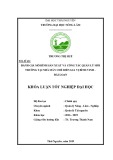
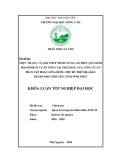
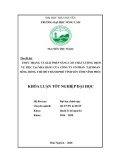

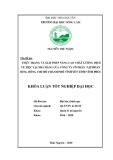
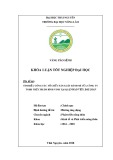
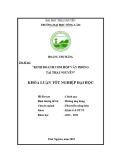
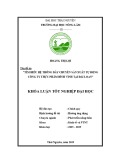

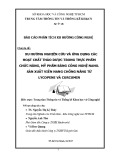

![Bệnh Leptospirosis: Khóa luận tốt nghiệp [Nghiên cứu mới nhất]](https://cdn.tailieu.vn/images/document/thumbnail/2025/20250827/fansubet/135x160/63991756280412.jpg)











